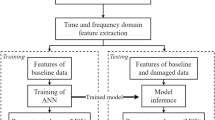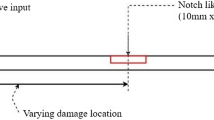Abstract
Deep networks can obtain the structural state features and optimize the parameters of the feature layer according to the training labels. The training data including the damage signals are quite helpful for detection model training, but sometimes the industrial damage signals are difficult to obtain, especially in airplane skin and other large structures. In this paper, a deep emulational semi-supervised probability imaging algorithm is proposed to present the damage state in the absence of damage samples. A promising signal generation method for simulated damage was implemented through signal encoding, ReLU activation and reconstruction with disturbance, and its effectiveness was verified in metal plate structures and anisotropic composite plate structures. The experiment results illustrate that the proposed method can detect the damage only using normal state signals, presents a good materials generalization in both aluminium plate and composite plate, and has better performance than other state-of-art methods.


















Similar content being viewed by others
References
Chua CA, Cawley P, Nagy PB (2019) Scattering of the fundamental shear guided wave from a surface-breaking crack in plate-like structures. IEEE Trans Ultrason Ferroelectr Freq Control 66(12):1887–1897
Mitra M, Gopalakrishnan S (2016) Guided wave based structural health monitoring: a review. Smart Mater Struct 25(5):053001
Moll J, Kathol J, Fritzen CP et al (2019) Open guided waves: online platform for ultrasonic guided wave measurements. Struct Health Monit 18(5–6):1903–1914
Chen G, Guo Y, Katagiri T et al (2021) Multivariate probability of detection (POD) analysis considering the defect location for long-range, non-destructive pipe inspection using electromagnetic guided wave testing. NDT and E Int 124:102539
Mei H, James R, Haider MF, Giurgiutiu V (2020) Multimode guided wave detection for various composite damage types. Appl Sci 10(2):484
Hong M, Mao Z, Todd MD, Su Z (2017) Uncertainty quantification for acoustic nonlinearity parameter in Lamb wave-based prediction of barely visible impact damage in composites. Mech Syst Signal Process 82:448–460
Khan A, Kim N, Shin JK et al (2019) Damage assessment of smart composite structures via machine learning: a review. JMST Adv 1(1):107–124
Mardanshahi A, Nasir V, Kazemirad S et al (2020) Detection and classification of matrix cracking in laminated composites using guided wave propagation and artificial neural networks. Compos Struct 246(112403):1–29
Wang Z, Huang S, Shen G et al (2022) High resolution tomography of pipeline using multi-helical Lamb wave based on compressed sensing. Constr Build Mater 317:125628
Peng Z, Jian J, Wen H et al (2020) Distributed fiber sensor and machine learning data analytics for pipeline protection against extrinsic intrusions and intrinsic corrosions. Opt Express 28(19):27277–27292
Jiménez AA, Zhang L, Muñoz CQG et al (2020) Maintenance management based on Machine Learning and nonlinear features in wind turbines. Renewable Energy 146:316–328
Harley JB, Alguri KS, Tetali HV et al (2019) Learning guided wave dispersion curves from multi-path reflections with compressive sensing. Struct Health Monit. https://doi.org/10.12783/shm2019/32388
Liu ZH, Peng QL, Li X et al (2020) Acoustic emission source localization with generalized regression neural network based on time difference mapping method. Exp Mech 60(5):679–694
Ebrahimkhanlou A, Salamone S (2018) Single-sensor acoustic emission source localization in plate-like structures using deep learning. Aerospace 5(50):1–22
Xu L, Yuan S, Chen J et al (2019) Guided wave-convolutional neural network based fatigue crack diagnosis of aircraft structures. Sensors 19(3567):1–18
Alguri KS, Chia CC, Harley JB (2021) Sim-to-Real: Employing ultrasonic guided wave digital surrogates and transfer learning for damage visualization. Ultrasonics 111:106338
Su C, Jiang M, Lv S et al (2019) Improved damage localization and quantification of CFRP using Lamb waves and convolution neural network. IEEE Sens J 19(14):5784–5791
Zhang B, Hong X, Liu Y (2021) Distribution adaptation deep transfer learning method for cross-structure health monitoring using guided waves. Struct Health Monit 21:14759217211010708
Mao J, Wang H, Spencer BF Jr (2020) Toward data anomaly detection for automated structural health monitoring: Exploiting generative adversarial nets and autoencoders. Struct Health Monit 1475921720924601:1–18
Lei X, Sun L, Xia Y (2020) Lost data reconstruction for structural health monitoring using deep convolutional generative adversarial networks. Struct Health Monit 1475921720959226:1–19
Xiong J, Chen J (2019) A generative adversarial network model for simulating various types of human-induced loads. Int J Struct Stab Dyn 19(08):1950092 (1-21)
Zhang B, Hong X, Liu Y (2020) Multi-task deep transfer learning method for guided wave-based integrated health monitoring using piezoelectric transducers. IEEE Sens J 20(23):14391–14400
Huthwaite P, Simonetti F (2013) High-resolution guided wave tomography. Wave Motion 50(5):979–993
Hay TR, Royer RL, Gao H (2006) A comparison of embedded sensor Lamb wave ultrasonic tomography approaches for material loss detection. Smart Mater Struct 15(4):946–951
Prasad SM, Balasubramaniam K, Krishnamurthy CV (2004) Structural health monitoring of composite structures using Lamb wave tomography. Smart Mater Struct 13(5):N73
Khodaei ZS, Aliabadi MH (2014) Assessment of delay-and-sum algorithms for damage detection in aluminium and composite plates. Smart Mater Struct 23(7):1–20
Chen Z, He G, Li J et al (2020) Domain adversarial transfer network for cross-domain fault diagnosis of rotary machinery. IEEE Trans Instrum Meas 69(11):8702–8712
Huang R, Li J, Liao Y et al (2020) Deep adversarial capsule network for compound fault diagnosis of machinery toward multidomain generalization task. IEEE Trans Instrum Meas 70:1–11
Liao Y, Huang R, Li J et al (2020) Deep semi-supervised domain generalization network for rotary machinery fault diagnosis under variable speed. IEEE Trans Instrum Meas 69(10):8064–8075
Li J, Huang R, He G et al (2020) A two-stage transfer adversarial network for intelligent fault diagnosis of rotating machinery with multiple new faults. IEEE/ASME Trans Mechatron 26:1591–1601
Liu Y, Hong X, Zhang B (2020) A novel velocity anisotropy probability imaging method using ultrasonic guided waves for composite plates. Measurement 166:108087
Zhang B, Hong X, Liu Y (2021) Deep convolutional neural network probability imaging for plate structural health monitoring using guided waves. IEEE Trans Instrum Meas 70(2510610):1–10
Funding
This work was supported by the National Natural Science Foundation of China under Grant No. 51975220, the National key Research and development program under Grant No. 2019YFB1804200, Guangdong Province Science & Technology project under Grant no. 2018B010109005 and Guangdong Outstanding Youth Fund under Grant No. 2019B151502057, the Fundamental Research Funds for Central Universities project under Grant No. 2019ZD23.
Author information
Authors and Affiliations
Corresponding author
Ethics declarations
Conflict of interest
The authors declare that they have no known competing financial or non-financial interests that could have appeared to influence the work reported in this paper.
Additional information
Publisher's Note
Springer Nature remains neutral with regard to jurisdictional claims in published maps and institutional affiliations.
Rights and permissions
About this article
Cite this article
Zhang, B., Yang, D., Hong, X. et al. Deep emulational semi-supervised knowledge probability imaging method for plate structural health monitoring using guided waves. Engineering with Computers 38, 4151–4166 (2022). https://doi.org/10.1007/s00366-022-01711-9
Received:
Accepted:
Published:
Issue Date:
DOI: https://doi.org/10.1007/s00366-022-01711-9




